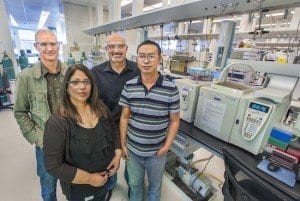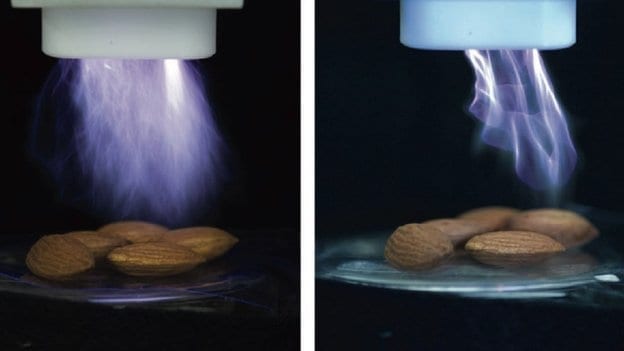
The efficient production of both biofuel and animal feed from 1 crop is now possible, and can be done on a farm without the need for off-site processes
The efficient production of both biofuel and animal feed from one crop is now possible, and can be done on a farm without the need for off-site processes. The research, published in the open access journal Biotechnology for Biofuels, demonstrates the practical potential of an alternative to fossil fuels that does not compete with food resources.
‘First-generation’ biofuels include ethanol produced from food sources such as corn and sugarcane. While recognized as a renewable energy source with potential to improve fuel security, their production has caused controversy over competing land-use for food and increased grain prices. The fermentation of non-food sources such as straw and wood, known as ‘second generation’ biofuels, has been promoted as a promising alternative, but also has its limitations.
First author Mitsuo Horita from the National Institute for Agro-Environmental Sciences, Japan, said: “Generally, the bottlenecks in second generation biofuel production include the need for large facilities, bulky material transport and complicated treatment processes, all of which are costly and consume a great deal of energy.
“What we’ve now demonstrated is a complete and scaled-up system which shows its potential in a practical on-farm situation. Instead of a complicated process requiring special facilities, our system simply builds upon traditional processes already used by farmers for producing silage for animal feed. It results in a high yield of ethanol while producing good quality feed, with zero waste.”
The process, known as ‘solid-state fermentation’, involves packing harvested whole rice plants with yeast and enzymes into a round bale wrapped in impermeable film. During incubation, sugars and starch in the rice plant are converted by yeast to ethanol, which accumulates and is then drained and distilled for fuel, leaving a bale of high quality animal feed in the form of silage.
In the tests, the process yielded up to 12.4 kg of pure ethanol per bale, after six months of incubation – ten times more ethanol than would result from natural silage production. A steady amount of ethanol also continuously drained out in the effluent from the bale during the test, resulting in an additional 1.7 kg of ethanol that could be easily collected without extraction.
Read more: Renewable biofuel production avoids competition with food resources
The Latest on: Renewable biofuel production
[google_news title=”” keyword=”Renewable biofuel production” num_posts=”10″ blurb_length=”0″ show_thumb=”left”]
via Google News
The Latest on: Renewable biofuel production
- Algae: King of Renewable Biofuels Or Fad Gone By?on May 1, 2024 at 10:46 pm
A researcher holds up laminaria saccharina sugar kelp algae in Southeast Alaska. Credit: David Csepp, NOAA/NMFS/AKFSC/Auke Bay Lab.
- Marathon refinery aims for 100% production capacity by end of yearon May 1, 2024 at 10:07 pm
Daniel Chereau leads IATA's fuel team, focusing on efficiency of fuel supply – including the ramp up of sustainable aviation fuels (SAF). He will be speaking on the second day of the Sustainable ...
- ATRI: Renewable Diesel a Better Emissions Option than BEVson May 1, 2024 at 1:39 pm
A new study by the American Transportation Research Institute has found that widescale use of renewable diesel fuel would be substantially cheaper than the adoption of electric trucks while delivering ...
- EPA approves renewable gasoline blendstock derived from researchers' inventionon May 1, 2024 at 12:04 pm
Science X is a network of high quality websites with most complete and comprehensive daily coverage of the full sweep of science, technology, and medicine news ...
- Iowa farmers' conservation practices to be a factor in renewable aviation fuel tax creditson May 1, 2024 at 5:56 am
Iowa and U.S. renewable fuel groups say the model is a good starting point but needs work to incorporate a wider variety of conservation practices as well as improvements in biofuels production. But ...
- Reimagining energy: How former fossil fuel sites are driving the renewable revolutionon April 30, 2024 at 6:28 am
Sustainable and renewable energy sources like solar and wind are all ... This move reflects a broader industry trend of repurposing existing infrastructure for biofuel production while concentrating ...
- The next big energy fight: Defense Production Act renewalon April 30, 2024 at 3:18 am
Republicans have little good to say about President Joe Biden using the national security law for renewable energy projects.
- New SAF tax credit model set to boost ethanol demandon April 29, 2024 at 6:37 am
As the aviation industry seeks to reduce its carbon footprint, SAF emerges as a critical component in achieving these environmental targets. The support through tax credits for ethanol producers ...
- Ethanol plant partnership aims for low-carbon cornon April 29, 2024 at 3:00 am
Red Trail Energy, the first ethanol plant in the nation to use carbon capture and storage, is launching a program to provide a premium price for farmers to grow low-carbon corn. Red Trail Energy is ...
- Verbio to expand South Bend's ethanol plant for renewable gason April 26, 2024 at 1:43 pm
The South Bend ethanol plant is planning a multi-year expansion project.German company Verbio biorefinery looking to make the first bio refinery in Indiana happ ...
via Bing News










